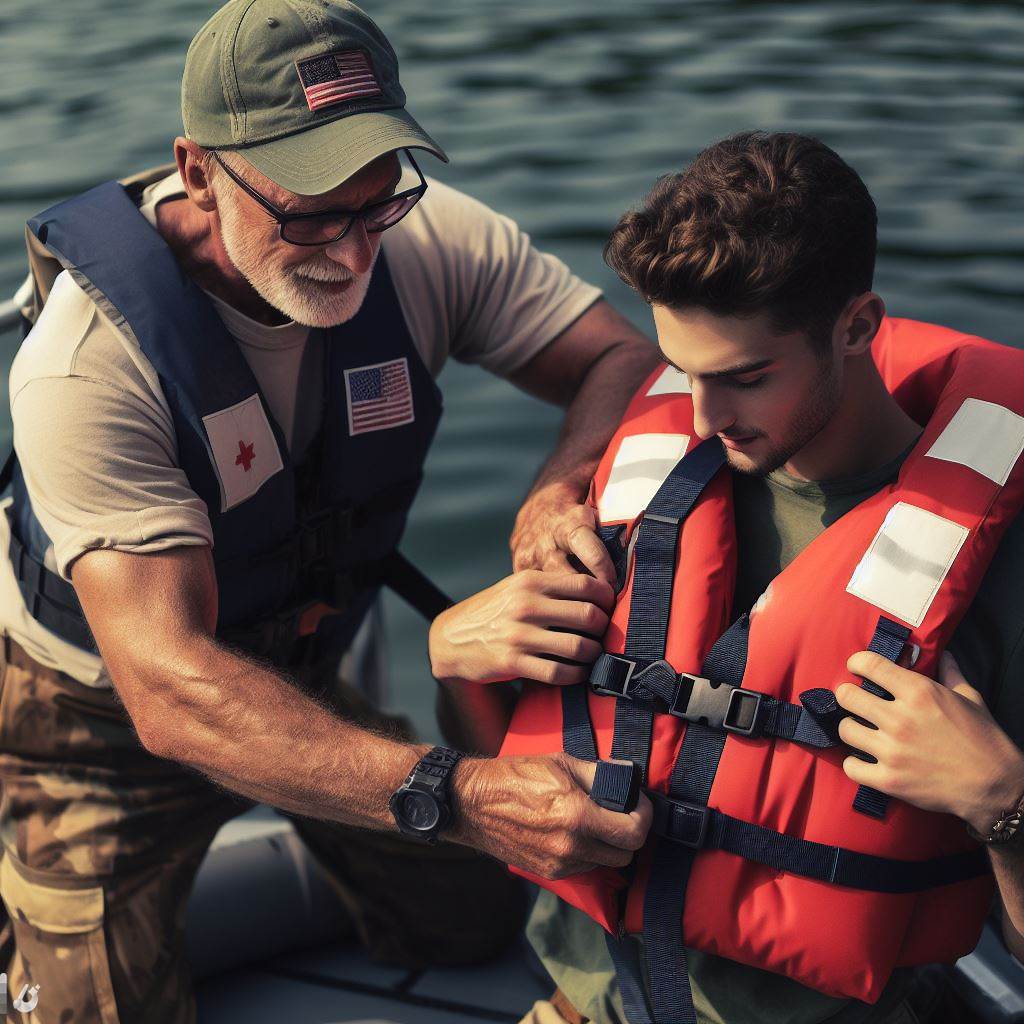Introduction
Safety protocols and training are of utmost importance in the fishing industry to protect American fishermen.
The challenging nature of their work exposes them to various risks and hazards that can jeopardize their lives and livelihoods.
By implementing strict safety measures and providing adequate training, the industry can significantly reduce accidents and fatalities.
The fishing industry in the United States is a vital sector that contributes to the nation’s economy and food supply.
It includes commercial and recreational fishing, supporting numerous jobs and coastal communities.
However, it is also recognized as one of the most dangerous industries, with high accident rates and occupational hazards.
Fishermen face multiple risks daily, such as adverse weather conditions, equipment malfunctions, and encounters with marine wildlife.
Without proper safety protocols and training, these risks can escalate into life-threatening situations.
Therefore, it is crucial for fishermen to be equipped with the necessary knowledge and skills to handle emergencies and prevent accidents.
Safety protocols ensure that fishermen are aware of potential dangers, are adequately prepared with safety equipment, and know how to react in emergencies.
Training programs should cover topics such as first aid, fire safety, navigation, and vessel maintenance.
By prioritizing safety, the fishing industry can protect its workforce, reduce injuries and fatalities, and enhance the overall well-being of American fishermen.
Generally, safety protocols and training are paramount for the safety and welfare of American fishermen.
As an industry that faces numerous risks, it is essential to implement strict safety measures and provide comprehensive training to mitigate hazards and protect lives.
Through a collective effort, we can make fishing a safer profession and ensure the sustainability of the fishing industry in the United States.
Importance of Safety Protocols
The risks and dangers faced by fishermen
Fishing is an occupation that exposes fishermen to various perils and hazards.
They navigate unpredictable and treacherous waters, confronting strong waves and gales.
Moreover, they are at risk of falling overboard or getting entangled in fishing nets and equipment.
Fishermen also encounter extreme weather conditions, such as storms and hurricanes.
The significance of preventive measures
Given the inherent risks associated with their profession, implementing rigorous safety protocols is crucial for fishermen.
Transform Your Career Today
Unlock a personalized career strategy that drives real results. Get tailored advice and a roadmap designed just for you.
Start NowThese protocols serve as a protective shield, mitigating potential dangers and minimizing the occurrence of accidents.
By adhering to safety measures, fishermen can safeguard their lives and avoid injuries that may lead to disabilities or even fatalities.
To ensure the effectiveness of preventive measures, rigorous training programs should be instituted.
These programs enhance fishermen’s awareness of potential hazards, equip them with necessary skills, and instill a safety-conscious mindset.
Safety trainings cover topics such as emergency response, first aid, proper use of safety equipment, and survival techniques.
Incidents highlighting the need for safety protocols
Several incidents in the past have emphasized the urgent need for effective safety protocols in the fishing industry.
For instance, the sinking of the F/V Destination in the Bering Sea in 2017 resulted in the loss of all six crew members.
This tragedy, caused by a combination of factors including icy conditions and improper stability assessment, reinforced the importance of safety measures.
Similarly, the sinking of the F/V Alaska Ranger in 2008 further highlighted the critical nature of safety protocols.
Despite having survival suits and other safety equipment onboard, five crew members lost their lives due to inadequate emergency response training.
This incident emphasized the essentiality of proper training and readiness to handle unforeseen emergencies.
Another incident that underlines the significance of safety protocols is the F/V Mary B II accident in 2019.
This crabbing vessel capsized near the coast of Oregon due to rough seas, resulting in the loss of three lives.
Unfortunately, the crew had not undergone proper safety training, and the vessel lacked stability precautions, leading to this tragic event.
These distressing episodes serve as stark reminders that neglecting safety protocols can have devastating consequences.
The loss of lives and the impact on families and communities reinforce the urgency of prioritizing safety in the fishing industry.
Essentially, safety protocols are of utmost importance for American fishermen due to the risks they face daily.
By recognizing the dangers and implementing preventive measures, such as rigorous safety protocols and comprehensive training, fishermen can protect themselves and reduce the occurrence of accidents and fatalities in their profession.
Read: US Fishing Regulations: Protecting Marine Life & Livelihoods
Showcase Your Business Today
Reach thousands of readers actively exploring professional services. Publish your business profile and grow your audience now.
Publish NowEssential Safety Protocols
Use of personal protective equipment (PPE)
- Fishermen must always wear appropriate PPE, including hard hats, gloves, and life jackets.
- PPE helps protect against injuries from falling objects, harsh weather conditions, and accidents at sea.
- Proper training should be provided to ensure fishermen understand the correct usage of PPE.
Guidelines for handling equipment and tools
- Fishermen should receive training on safe handling techniques for fishing equipment and tools.
- It is essential to maintain a firm grip and use proper body mechanics to prevent injuries.
- Regular inspections and maintenance of equipment and tools are crucial to ensure their safe operation.
Understanding and implementing emergency response procedures
- Fishermen should be well-trained in emergency response procedures and drills.
- This includes knowing how to use safety equipment, such as fire extinguishers and life rafts.
- Regular practice of emergency response exercises helps build muscle memory and improves response time.
Regular vessel maintenance and inspections
- Fishermen must prioritize regular maintenance and inspections of their vessels.
- This includes checking the integrity of hulls, engines, navigation systems, and safety equipment.
- Regular maintenance helps identify potential issues early on and prevents accidents at sea.
Need for proper safety signage and documentation
- Important safety signs must be prominently displayed on vessels to provide clear instructions.
- These signs ensure fishermen can quickly locate safety equipment and follow emergency procedures.
- Proper documentation of safety protocols, training sessions, and maintenance records is crucial for compliance.
Basically, strict adherence to essential safety protocols is crucial for American fishermen’s safety at sea.
The use of personal protective equipment, proper handling of equipment and tools, understanding and implementing emergency response procedures, regular vessel maintenance and inspections, and the need for safety signage and documentation are fundamental aspects that cannot be overlooked.
By prioritizing safety protocols and providing adequate training, we can minimize the risks associated with the fishing industry and ensure the well-being of our fishermen.
Read: The Role of Women in the US Fishing Industry
Training Programs for Fishermen
Overview of available safety training programs
- The fishing industry offers various safety training programs to ensure the well-being of fishermen.
- These programs cover a wide range of topics including first aid, emergency response, and vessel safety.
- Many training programs also include instruction on the proper use of safety equipment and personal protective gear.
- These programs are designed to equip fishermen with the necessary skills and knowledge to prevent accidents and respond effectively in emergencies.
Information on reputable organizations offering training courses
- There are several reputable organizations that offer safety training courses for fishermen.
- The U.S. Coast Guard provides training through its Fishing Vessel Safety Program, aimed at preventing accidents and promoting safety practices.
- The National Institute for Occupational Safety and Health (NIOSH) also offers free training programs specifically tailored to the fishing industry.
- Other organizations such as the American Red Cross and the Occupational Safety and Health Administration (OSHA) provide valuable resources and training materials.
The benefits of participating in these programs
- Participating in safety training programs helps fishermen gain essential knowledge and skills to protect themselves and their colleagues.
- These programs educate fishermen on recognizing potential hazards and taking appropriate measures to prevent accidents.
- Training programs also promote a safety culture within the fishing industry, ensuring that safety is prioritized by all individuals involved.
- Equipped with this training, fishermen can reduce the risks associated with their occupation and increase their overall well-being.
Importance of ongoing training and refresher courses
- Ongoing training and refresher courses are crucial for fishermen to remain updated on safety protocols and practices.
- The fishing industry evolves, and new hazards and safety measures emerge regularly, making continuous education essential.
- Refresher courses help reinforce the knowledge gained from initial training, ensuring that fishermen remain vigilant and competent in safety procedures.
- By participating in ongoing training, fishermen can adapt to changing regulations and technologies, ultimately enhancing their safety and job performance.
Overall, the availability of safety training programs for fishermen is crucial in mitigating risks in the fishing industry.
Participating in these programs, offered by reputable organizations, provides fishermen with the necessary skills to protect themselves and prevent accidents.
Ongoing training and refresher courses are equally important to keep up with evolving safety protocols.
By prioritizing safety through these training programs, the fishing industry can ensure the well-being of its workforce and promote a safer environment for all.
Read: Impact of Climate Change on US Fishing Grounds

Government Regulations and Compliance
Federal, state, and local regulations in the fishing industry.
Commercial fishing in the United States is subject to various regulations at different governmental levels.
At the federal level, the National Marine Fisheries Service (NMFS), under the National Oceanic and Atmospheric Administration (NOAA), oversees the implementation and enforcement of regulations related to fishing in federal waters.
These regulations include limits on catch sizes, quotas, fishing seasons, and gear restrictions.
State governments also play a role in regulating fishing activities within their territorial waters.
Each state has its own Fish and Wildlife agency responsible for managing and enforcing fishing regulations.
These regulations may include additional restrictions specific to the state, such as permit requirements, size limits, and protected areas.
Local governments, such as cities or municipalities, may have their own regulations that further restrict fishing activities.
These regulations are often implemented to address local or regional concerns, such as conservation efforts or protection of specific species.
The role of agencies responsible for enforcing safety regulations.
Agencies responsible for enforcing safety regulations in the fishing industry have a critical role in ensuring the well-being of fishermen.
The NMFS and state Fish and Wildlife agencies work together to enforce safety regulations, focusing on areas such as vessel safety, equipment maintenance, and crew training.
These agencies conduct regular inspections, often unannounced, to ensure compliance with safety regulations.
They may examine documentation related to vessel inspections, safety equipment, and crew training records.
In cases of non-compliance, they have the authority to issue citations, fines, and even suspend or revoke licenses.
Overview of the consequences for non-compliance.
Non-compliance with safety regulations in the fishing industry can have severe consequences.
Aside from the potential risks to the safety and well-being of fishermen, violations can result in significant financial penalties and legal implications.
Penalties for non-compliance vary depending on the severity of the violation and the jurisdiction.
Fines can range from hundreds to thousands of dollars per violation.
In some cases, repeated or egregious violations can lead to the suspension or revocation of fishing licenses, which can have devastating effects on the livelihoods of fishermen and the fishing communities they support.
Importance of promoting a safety culture within the industry.
Promoting a safety culture within the fishing industry is crucial to protect the lives and well-being of fishermen.
Safety protocols and training alone are not enough; they must be embraced and prioritized by all individuals involved.
By fostering a safety culture, fishermen develop a mindset that prioritizes safety over productivity.
This includes regular safety training, proactive equipment maintenance, and open communication between crew members and management regarding safety concerns.
A strong safety culture not only benefits fishermen but also contributes to the long-term sustainability of the fishing industry.
By reducing accidents, injuries, and fatalities, the industry can ensure its viability while safeguarding the livelihoods of those who depend on it.
To sum it up, government regulations and compliance play a vital role in ensuring the safety of American fishermen.
Understanding the federal, state, and local regulations that govern the fishing industry, as well as the consequences for non-compliance, is essential for both fishermen and industry stakeholders.
Embracing and promoting a safety culture within the industry is equally important to prioritize the well-being of fishermen and sustain the fishing industry for generations to come.
Read: Diverse Techniques: Traditional vs. Modern Fishing Methods
Successful Implementation of Safety Protocols
Strategies for effective communication and training dissemination
- Develop clear and concise safety manuals and guidelines.
- Utilize visual aids and multimedia presentations to enhance training materials.
- Conduct regular safety meetings to review protocols and address any concerns.
- Utilize electronic communication platforms to disseminate safety updates and reminders.
- Implement a buddy system to promote peer-to-peer communication and accountability.
- Encourage open dialogue and feedback between crew members and management.
- Provide language and cultural sensitivity training for diverse crews.
- Ensure training materials are accessible and understandable to all crew members.
- Utilize real-life scenarios and case studies to highlight the importance of following safety protocols
- Conduct regular drills and simulations to reinforce training and improve response times.
Encouraging crew participation and engagement in safety practices
- Involve crew members in the development and revision of safety protocols.
- Provide incentives for crew members who consistently adhere to safety protocols.
- Recognize and reward crews for their safety records and contributions.
- Offer ongoing safety training and professional development opportunities.
- Encourage a proactive safety culture where crew members actively identify and report hazards.
- Ensure crew members have the necessary resources and equipment to prioritize safety.
- Promote ownership and responsibility for safety by assigning designated safety roles within the crew.
- Provide mentoring and coaching programs to support new crew members in adopting safety practices.
- Regularly evaluate and update safety protocols based on crew feedback and lessons learned.
- Foster a supportive and inclusive environment where crew members feel comfortable raising safety concerns.
Collaboration with industry associations, research institutions, and government bodies
- Partner with industry associations to access and share best practices in safety protocols.
- Collaborate with research institutions to conduct studies and develop evidence-based safety strategies.
- Engage with government bodies to stay updated on regulatory requirements and participate in safety initiatives.
- Participate in industry conferences and workshops to stay informed about the latest safety developments.
- Share successful safety initiatives with industry associations and government bodies to promote wider adoption.
- Work with research institutions to evaluate the effectiveness of safety protocols and identify areas for improvement.
- Establish industry-wide safety standards in collaboration with relevant stakeholders.
- Participate in industry-wide safety audits and inspections to benchmark performance and identify areas for improvement.
- Share research findings and collaborate on safety projects with research institutions.
- Advocate for government support and funding for safety training programs and initiatives.
Sharing success stories and case studies of improved safety outcomes
- Highlight success stories of improved safety outcomes through internal and external communication channels.
- Share case studies of incidents where following safety protocols prevented accidents or minimized harm.
- Showcase crew members who have shown exceptional commitment to safety and achieved positive outcomes.
- Organize safety-focused events where successful practices and outcomes are celebrated and shared.
- Use social media platforms to share safety success stories and promote the importance of safety protocols.
- Collaborate with industry publications to publish articles and features on successful safety initiatives.
- Create a repository of safety-related resources, including case studies, videos, and testimonials.
- Invite guest speakers to share their experiences and insights on safety practices and their impact.
- Use employee newsletters and internal communication channels to regularly share safety success stories.
- Encourage crew members to share personal anecdotes and experiences that emphasize the importance of safety.
Continuous Improvement and Emerging Technologies
Integration of new technologies for enhancing safety in fishing operations
- New technologies play a crucial role in improving safety regulations and practices for American fishermen.
- The integration of advanced equipment and systems helps in reducing accidents and fatalities at sea.
- Safety measures, like GPS tracking systems and satellite communication, improve response time during emergencies.
- Emerging technologies, such as remote monitoring and automation systems, minimize human error and enhance operational safety.
Examples of innovative solutions being utilized
- Underwater drones equipped with cameras enable fishermen to assess potential hazards underwater.
- Specialized sensors and software provide real-time data on weather conditions, ensuring safe fishing practices.
- Personal protective equipment (PPE) advancements, like lightweight materials and improved designs, enhance fishermen’s safety.
- Training programs utilizing virtual reality (VR) simulations help fishermen develop critical decision-making skills in dangerous situations.
Importance of adapting to evolving safety practices and equipment
- Fishermen must actively adapt to changing safety protocols and embrace emerging technologies.
- Continuous improvement in safety practices ensures higher levels of protection for fishermen.
- Regular training sessions should be conducted to educate fishermen about new safety measures and equipment.
- Collaboration between industry stakeholders, researchers, and regulatory agencies is crucial for identifying and implementing best safety practices.
American fishermen embrace innovative safety measures like underwater drones and real-time weather monitoring.
These tools enhance risk assessment, enabling informed decisions.
Lightweight, advanced PPE ensures comfort without compromising safety.
Showcase Your Business Today
Reach thousands of readers actively exploring professional services. Publish your business profile and grow your audience now.
Publish NowVR simulations in training develop crucial decision-making skills.
Regular sessions keep fishermen updated on evolving safety protocols.
Collaboration among stakeholders, researchers, and regulators is pivotal for comprehensive safety.
Continuous improvement, integrating emerging technologies, fosters a safer environment, boosting fishermen’s confidence in navigating challenging waters.
Conclusion
Ensuring the safety of American fishermen is of utmost importance in the fishing industry.
With the hazardous conditions they face on a daily basis, implementing strict safety protocols and providing adequate training can save lives.
By prioritizing safety protocols and training, the industry can significantly reduce the number of accidents and fatalities.
This not only protects the well-being of fishermen but also ensures the continuity of their livelihoods.
It is crucial for industry leaders, policymakers, and stakeholders to recognize this and take immediate action.
The fishing industry needs to invest in comprehensive safety training programs.
This includes educating fishermen about potential risks, equipping them with proper safety gear, and teaching them emergency response procedures.
Safety training should be an ongoing process, with regular updates and refreshers to maintain awareness and preparedness.
Improved safety measures have the potential to revolutionize the fishing industry.
By reducing accidents and injuries, fishermen can experience improved physical and mental well-being, leading to increased efficiency and productivity.
Moreover, a safer working environment will attract more individuals to pursue a career in fishing, addressing the labor shortage faced by the industry.
Safety protocols and training should never be undermined in the fishing industry.
The lives of American fishermen are at stake, and it is our collective responsibility to ensure their safety.
Industry leaders must prioritize safety and invest in comprehensive training programs to protect the well-being of fishermen and secure the future of the industry.
[E-Books for Sale]
The Big Book of 500 High-Paying Jobs in America: Unlock Your Earning Potential
$19.99 • 500 High-Paying Jobs • 330 pages
Explore 500 high-paying jobs in America and learn how to boost your career, earn more, and achieve success!
See All 500 High-Paying Jobs of this E-Book
1001 Professions Without a Degree: High-Paying American Jobs You Can Start Now
$19.99 • 1001 Professions Without a Degree • 174 pages
Discover 1001 high-paying jobs without a degree! Unlock career tips, skills, and success strategies for just $19.99!




